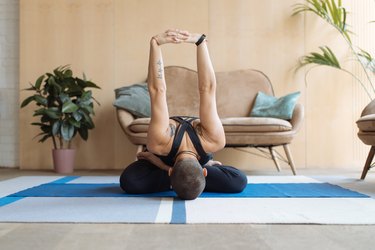
The shoulder joint is a shallow ball-and-socket joint between the humerus — upper-arm bone — and the glenoid fossa of the scapula — shoulder blade. It is one of the most mobile joints in the body.
A unique joint, the shoulder has only one bony attachment to the rest of the skeleton between the collarbone and the breastbone. This unique anatomy allows a wide range of normal shoulder range of motion (ROM), including abduction, flexion, extension, lateral rotation and medial rotation.
Video of the Day
Video of the Day
Read more: 5 Exercises to Do When Shoulder Pain Flares Up
Tip
The shoulder is one of the most mobile joints in the body, moving front to back, side to side and rotating inward and outward. Shoulder ROM norms exist for these movements, but individual abilities can vary significantly.
Normal Shoulder Range of Motion
Shoulder ROM norms exist, as listed by the Family Practice Notebook. These numbers can vary slightly, depending on your reference source or textbook.
However, as pointed out in a September 2012 article published by Sports Medicine, Arthroscopy, Rehabilitation, Therapy & Technology, "normal" shoulder range of motion is dependent upon arm dominance, age, gender and lifestyle factors such as sports participation.
The shoulder joint moves into abduction, flexion, extension, internal rotation and external rotation — with different shoulder ROM norms for each.
Joint range of motion is measured with a goniometer, with specific landmarks and techniques for each movement.
1. Abduction
Abduction is a term that refers to a body part moving out to the side, away from the midline of the body. Abduction range of motion is measured with the palm facing the side of the body and the arm held straight.
Abduction, as demonstrated by the University of Scranton, is measured from neutral — the arm lying at the side of the body — to the highest point the arm can be lifted. Normal range is 150 degrees.
2. Flexion
Flexion is also referred to as shoulder forward flexion. This is the motion of the shoulder when lifting the arm in front of the body, such as to point at something in front of you.
Flexion range of motion is measured with the palm facing the side of the body and the arm straight. It is measured from neutral to the highest point the arm can be lifted over the head. Normal shoulder forward flexion range of motion is 150 to 180 degrees.
3. Extension
Extension is a shoulder motion that involves moving the arm straight back, behind the body. Range of motion is measured with the palm facing the side of the body and the arm straight.
Extension is measured in a prone, or face-down position, from neutral to the highest point the arm can be lifted behind the back. Normal range of motion for extension is between 45 to 60 degrees.
4. Lateral/External Rotation
Lateral rotation is often referred to as external rotation. It is a motion that is performed with the elbow bent to 90 degrees and swinging the forearm away from the body, such as when opening a cabinet door.
External rotation is measured while lying down on your back, with the shoulder abducted 90 degrees and elbow bent to 90 degrees. The forearm then drops backward as far as possible, into external rotation, according to the University of Scranton.
5. Medial/Internal Rotation
Medial rotation is often referred to as internal rotation. It is a motion that is performed with the elbow bent to 90 degrees and swinging the forearm toward the body, such as when closing an open cabinet door.
Internal rotation is measured while lying down on your back, with the shoulder abducted 90 degrees and elbow bent to 90 degrees. The forearm then drops forward as far as possible, into internal rotation.
- Family Practice Notebook: "Shoulder Range of Motion"
- Sport Medicine, Arthroscopy, Rehabilitation, Therapy & Technology: "Clinical Descriptive Measures of Shoulder Range of Motion for a Healthy, Young, Physically Active Cohort"
- University of Scranton: "Goniometry: Shoulder Flexion"
- University of Scranton: "Goniometry: Shoulder Medical (Internal) Rotation)"
- University of Scranton: "Goniometry: Shoulder Abduction"
- University of Scranton: "Goniometry: Shoulder Lateral (External) Rotation)"
- University of Scranton: "Goniometry: Shoulder Extension"
Is this an emergency? If you are experiencing serious medical symptoms, please see the National Library of Medicine’s list of signs you need emergency medical attention or call 911.